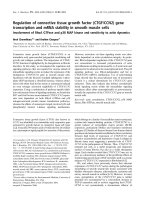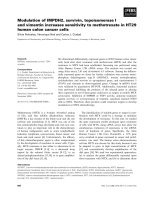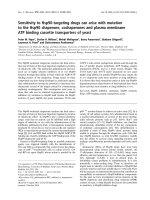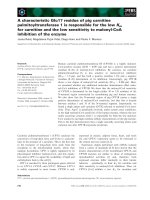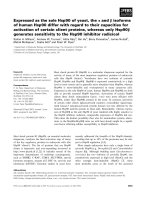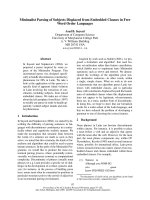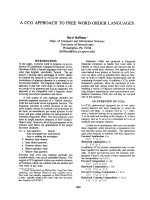Speakers sensitivity to rules of frozen word order
Bạn đang xem bản rút gọn của tài liệu. Xem và tải ngay bản đầy đủ của tài liệu tại đây (883.14 KB, 12 trang )
JOURNAL OF VERBAL LEARNING AND VERBAL BEHAVIOR 18,
49%508 (1979)
Speakers' Sensitivity to Rules of Frozen Word Order
STEVEN P I N K E R AND D A V I D BIRDSONG
Harvard University
Certain idioms called "freezes," e.g.,first andforemost, mish-rnash,displaya characteristic fixed
word order determined by phonological and semantic rules. Native speakers of English and
learners of English were asked to indicate their preferences for one of two possible orderings of
minimally contrasting nonsense pairs, e.g., FIM FUM versus FUM-FIM. Both native and
beginning speakers' judgments respected rules claimed to be universal; only native speakers'
judgments respected those rules for which evidence for universality is lacking. In a second study,
French native speakers and English native speakers learning French judged French-sounding
pairs. Once again, overall judgments respected the putatively universal rules; but only the English
speakers' judgments respected the putatively English-specific rules. It is concluded that rules of
frozen word order are psychologically real, with the possible function of aiding speech perception.
T h e class of i d i o m - l i k e expressions k n o w n
as "freezes" constitutes one of those linguistic
d o m a i n s in w h i c h a n a p p a r e n t l y superficial
p h e n o m e n o n is f o u n d to be g o v e r n e d b y
surprisingly o r d e r l y a n d deeply r o o t e d prin-
ciples. Referred to b y m a n y n a m e s a n d
p r e v a l e n t in m o s t languages, freezes include
irreversible c o n j o i n e d phrases such as wear
and tear, hook, line, and sinker, first and
foremost; a n d fixed reduplicatives, which subdivide into vowel alternations, e.g., pitterThe order of authors was determined by the Vowel patter, ping-pong; a n d into r h y m i n g terms
Quality Principle. Portions of this paper were presented such as super-duper, razzle-dazzle, a n d hocusat the Third Annual Boston University Conference on pocus. I n all of these expressions, the salient
Language Development, September 1978. The research a n d defining c h a r a c t e r i s t i c - - a n d the focus of
reported here comprises part of the second author's
o u r i n v e s t i g a t i o n - - i s the fixed o r "frozen"
doctoral dissertation submitted to the Department of
linear
o r d e r of their c o n s t i t u e n t terms.
Romance Languages, Harvard University. We are grateL i t e r a l l y dozens of principles p u r p o r t i n g to
ful to Lloyd Anderson, Roger Brown, William Cooper,
Wilga Rivers, Jean-Pierre Montreuil, Dan Slobin, and a c c o u n t for this i n v a r i a b i l i t y have been p r o especially to John R. Ross for helpful discussions and posed. T h e principles r a n g e from a d hoc,
advice; to J.-P. Montreuil and Faith Steinberg for assislanguage-specific rules (e.g., A b r a h a m , 1950;
tance in preparing the stimulus materials; and to Nancy
Etcoff and Roger Tobin for assistance in data analysis. Of Scott, 1913; M o r a w s k i , 1927) to powerful,
course, none is to be blamed for the paper's faults. The universal, or quasi-universal principles (e.g.,
staffand students in Romance Languages at Harvard, and Jespersen, 1942; M a r c h a n d , 1969; M a l k i e l ,
in the English as a Second Language programs at Boston 1968). T h e consensus a m o n g m o d e r n linguists
University, Harvard, and the International Institute, also
is t h a t b o t h p h o n o l o g i c a l a n d s e m a n t i c factors
deserve sincere thanks. This research was supported by
Graduate Student Research Funds from the Department are r e s p o n s i b l e for w o r d o r d e r i n g in freezes.
P u r e l y s e m a n t i c factors seem to be preof Psychology and Social Relations, Harvard University,
to the first author, who was supported by a NRC Canada e m i n e n t in d e t e r m i n i n g w o r d o r d e r in irreverPostgraduate Scholarship. Address reprint requests to sible c o n j o i n e d phrases. C o o p e r a n d Ross
either the second author, now at the Department of French
and Italian, University of Texas, Austin, Texas 78712, or (1975) suggest a b r o a d principle which rules
the first author, now at the Center for Cognitive Science, t h a t first m e m b e r s of c o n j o i n e d expressions
2019-105, M.I.T., Cambridge, Massachusetts 02139.
refer to those features which describe o r
497
0022-5371/79/040497 12$02.00/0
Copyright © 1979 by AcademicPress, Inc.
All rights of reproduction in any form reserved.
Printed in Great Britain
498
PINKER AND BIRDSONG
pertain to the prototypical speaker (hence, the (Note 1) has found some of these constraints
"Me First" principle). The first elements tend apparently active in languages other than
to be, e.g.:
English, although as yet there are no exhaustive or definitive studies to support
Living the quick and the dead," life or
death
a universal application of the "Me First"
principle.
Adult parent and child; men, women,
and children
The absence of semantic considerations in
Male man and woman; brother and
many freezes naturally raises the question of
sister
sound. Why does stuff and nonsense sound
Animate person, place or thing
better than nonsense and stufff Why mumbojumbo, hem and haw, helter-skelter, and so on,
Here here and there; this and that
but not their order-reversed counterparts?
Now now and then; sooner or later
Agentive cat and mouse; !hunter and hunted Seven phonological constraints on such
semantics-independent freezing have been
Patriotic Cowboys and Indians; the
proposed by Cooper and Ross (1975), and are
Dartmouth-Harvard~
reproduced with examples in Table 1. Their
Harvard-Dartmouth game
list incorporates and distills most of the find(depending on the
ings of the literature prior to 1975, while
speaker's alma mater)
making original contributions as well. These
Such semantic features are determinants in constraints are listed by Cooper and Ross in
most irreversible conjoined phrases display- rough descending order of their strengths in
ing marked semantic differences between their "tugs of war" with one another: When two
constituent members. Interestingly, Ross principles are applicable in a single freeze, but
TABLE 1
PHONOLOGICAL CONSTRAINTSON FREEZING AS PROPOSED BY COOPER AND ROSS (1975)
Constraint
First element will have
Second element will have
Examples
(1) N u m b e r of syllables
(Panini's Law)
(2) Vowel length
(3) N u m b e r of initial
consonants
(4) Quality of initial
consonant a
Fewer syllables
More syllables
kit and caboodle
stuff and nonsense
stress and strain
helter-skelter
fair and square
huff and puff
namby-pamby
(5) Vowel quality b
(6) N u m b e r of final
consonants
(7) Quality of final
consonant
Short vowels
Long vowels
Fewer initial
More initial
consonants
consonants
Less obstruent
More obstruent
(more sonorant)
(less sonorant)
initial consonant
initial consonant
More closed or
More open or
more front vowel
more back vowel
(Decreasing second formant frequency)
More final
. Fewer final
consonants
consonants
More obstruent
Less obstruent
(less sonorant)
(more sonorant)
final consonant
final consonant
a Consonants are ordered from least to most obstruent as follows:
h < Glides < Liquids < Nasals < Spirants < Stops
v~,y
1,r
m,n
f,v,s,z,th,sh p,b,t,d,k,g.
b Vowels are ordered from highest to lowest second formant frequency as follows:
/i/>/I/>/~/>/~e/>/u/> 2/;/~/o/~ In/.
dribs and drabs
flip-flop
betwixt and between
kith and kin
push and pull
FROZEN W O R D ORDER
they dictate different word orders, the principle that is consistent with the actual word
order is said to be stronger than the other one.
Thus in boots and saddles, the Law of Syllable
Number (often called Panini's Law after the
4th Century B.C. Sanskrit linguist who first
formulated it) tugs with the Vowel Length
rule, but the former wins out and is therefore
considered stronger. (Cooper and Ross point
out, however, that their hierarchy is based on
incomplete evidence.)
Other related research summons scores of
extant examples from diverse languages in
support of Panini's Law (Jespersen, 1972;
Bolinger, 1962; Behaghel, 1909; Morawski,
1927; Malkiel, 1968; Scott, 1913; Abraham,
1950), and, to a degree, in support of the final
consonant quality rule (Bolinger, 1962) and
the initial consonant quality rule (Morawski,
1927; however, cf. Campbell & Anderson,
1976). The literature also lends firm support to
the near-universal application of a vowel rule
related to the second formant rule of Cooper
and Ross. However, the rule is generally
formulated in terms of a high-vowel/lowvowel alternation; that is, taking account of
the frequency not of the second formant but of
the first, whose frequency varies inversely with
vowel height (Jespersen, 1942; Abraham,
1950; Marchand, 1969; Cutler & Cooper,
1978). The orderings of vowels dictated by
the two criteria differ as follows: in terms
of decreasing second formant frequency, the
ordering is (Ladefoged, 1975):
/i/, /I/, /~/, /~e/, / a/, / o/,/~/,and/u/;
in terms of increasing first formant frequency,
the ordering is (Ladefoged, 1975):
/i/, /u/, /I/, /o/, /e/, /~/, /~e/, and/a/.
Recently there have been a number of
claims concerning the functional significance
of principles of frozen word order: for example, that the principles facilitate the processing of information in speech comprehension
(Cooper & Ross, 1975; Cutler & Cooper,
1978), that they are suggestive of the "con-
499
ceptual space" of the speaker (Ross, Note 2);
that they constitute an example of "phonetic
symbolism" (Tanz, 1971; cf. Brown, 1958;
Diffloth, 1972); or that they reflect the "markedness" of semantic dimensions (Cooper &
Ross, 1975; cf. Clark, Carpenter, & Just, 1973).
Accordingly, we see the need for experimental
evidence to corroborate existing linguistic
(lexical) evidence, i.e., the set of freezes found in
a given language corpus.
First, we wanted to demonstrate the
"psychological reality" of Cooper and Rosstype phonological principles which mandate
word order. If, for example, we can demonstrate that naive speakers consistently indicate
that nonsense paired terms ordered according
to the dictates of a given principle "sound
better" than the same terms ordered otherwise, we will have evidence for a mechanism
in part responsible for the speakers' "feel
for" a language. Such a mechanism has been
implicated by Campbell and Anderson (1976)
and by Cooper and Ross (1975) in the formation of freezes, according to an analogy
with Darwinian evolution: Those conjoined
phrases in everyday discourse that "sound
right" (that conform to the principles) are
most likely to "survive" and become conventional in the language. Evidence for such a
mechanism would support the Darwinian
metaphor and rule out the possibility that
freezes came into being through historical or
accidental factors.
A second goal is to ascertain the universality of a given principle. 1 To the extent that
Rule X is universal, we hypothesize that
subjects should consistently prefer the specified order of items in nonsense pairs varying
minimally according to Rule X, regardless of
the subjects' knowledge of or familiarity with
the language upon whose phonetic system the
1 Some languages (e.g., Yiddish, Hindi, Turkish) seem
to invert systematically some or all of the phonological
rules, and isolated exceptions to the rules appear in a
n u m b e r of languages. Thus "'universal" as employed
henceforth should be taken to mean "near universal."
500
PINKER AND BIRDSONG
TABLE 2
TYPES AND DEGREESOF EVIDENCE FOR PHONOLOGICAL RULESOF FROZENWORDORDER
Rule
Cross-linguistic evidence
Englishexamples
Literature
Panini's law
Strong
Cited most often
Vowel quality
Vowel length
Strong
Weak, but may be
an extension of
Panini's Law
Moderate, but
inconsistent
Many, mostly
irreversible
polynomials
Many, all types
Few, but has been
found to override
semantic rules
Many, esp.
reduplicatives;
'but many counterexamples
No existing
minimally
contrasting examples
Initial consonant
obstruency
Number of final
consonants
?
nonsense words are based. A cross-linguistic
test, fashioned similarly, should provide corroborating evidence for universality. A related
goal is to determine'a ranking of phonological
principles, from strong, universal ones to weak
and/or language specific ones, based on unconfounded evidence. Since a multiplicity of
semantic and phonological factors may be at
work in most English freezes, it is often
impossible for investigators to decide a m o n g
differing characterizations of rules or to ascertain their relative strengths. However, with
a set of minimally contrasting nonsense pairs,
determining factors can be teased apart.
Accordingly, we selected five of the phonological principles for testing, predicting a
strength/universality ranking based on three
criteria: cross-linguistic evidence for a given
principle; actual numbers of unconfounded
lexicalized English freezes governed by a given
principle; and discussion in the literature we
have cited. This ordering and its supporting
evidence are summarized in Table 2.
EXPERIMENT I
Subjects
Forty-eight adults, most with some college
education, participated in the experiment.
Cited often
Cited only in Cooper
and Ross (1975)
but ranked high
Cited often
Cited only in
Cooper and Ross
(1975)
Sixteen were native speakers of English; 16
had just begun their study of English and were
rated by their English teachers at 1 to 1.5 on a
5-point scale of fluency; 16 were at the intermediate level and scored 3 to 4 out of 5 on the
fluency scale. Subjects from the latter two
groups were enrolled in English as a Second
Language programs at H a r v a r d and Boston
University Summer Schools, or were regular
students at the International Institute in
Boston, a second-language
instruction
institution)
Materials
The 50-item questionnaire was composed of
10 nonsense exemplars varying minimally
according to each of the five chosen principles,
and obeying the sound patterns of English.
Care was taken to avoid items reminiscent
of existing lexicalized freezes. The first 25
exemplars were placed at the ends of plausible
sentences, while the last 25 were presented in
ZNative languages of beginners were as follows:
Spanish (6 subjects); Japanese (4); Chinese, Persian,
Hebrew, Korean, Arabic, Portuguese (1 each). Native
languages of intermediates were: Spanish (4); Italian (3);
French (2); Vietnamese, Japanese, German, SwissGerman, Basque, Yiddish, Armenian (1 each).
FROZEN WOR D ORDER
isolation. Some examples are listed below for
each principle.
Panini's Law
The falling Martian tumbled P L U P over
GEPLUP.
My car is so old that it goes BOOF and
KABOOF.
D I L K or SPLADILK.
DABIG and DADABIG.
Vowel Quality
In baseball games I am an uncoordinated
FIM-FUM.
The wet cereal was all GLIGY and
GLAGY.
F E L A C K E R Y and FELOCKERY.
REPPO and ROPPO.
Vowel Length
All the game consisted of was
M O T C H I N G and M O A T C H I N G .
Before going to bed, most men remove
their SMATS and SMATES.
BRETS or BRAITS.
F R I N N I N G and FREENING.
Initial Consonant Obstruency
My lover looked at me and tenderly
kissed my WAF-PAF.
I wouldn't have asked you if I'd known
you would do it all RASBY and DASBY.
LESH-GESH.
HAIPO and DAIPO.
Number of Final Consonants
The dead man was found lying
BEGROAST and BEGROAT.
That radical new theory was merely
SWIRP and SWIRR.
FLARD and FLAR.
SKALK and SKALL.
Sentences were presented as follows:
GLAGY and GLIGY.
The wet cereal was all GLIGY and GLAGY.
(A) GLAGY
and G L I G Y
[ l l l l l
Aa ? bB
GLIGY and
GLAGY (B)
Exemplars of the different principles were
randomly scattered throughout the questionnaire, and the order of terms in each exemplar
501
was counterbalanced across subjects within
each proficiency group.
Procedure
Subjects were asked to listen to a native
speaker's recorded reading of the test while
reading silently along on their questionnaires
(subvocalizing was also permitted). Detailed
instructions as well as practice examples were
provided until it was certain that each subject
understood completely the procedure. Testing
took place in small groups or individually,
under good-to-excellent acoustic conditions.
Results and Discussion
Mean ratings of the different classes of
items by different groups of subjects are
illustrated in Figure 1. Means above 3.0
indicate preference for the order dictated
by the appropriate phonological principle,
means near 3.0 indicate indifference, and
means below 3.0 indicate preference for the
order contrary to the one dictated by the
appropriate principle. The principles are
placed along the abscissa in order of decreasing
predicted strength. Filled circles represent
means that are significantly different from
3.0 (p < .05, two-tailed t test) when measured
against both subject and item variability;
half-filled circles represent means that are
significantly different from 3.0 when measured
against subject variability only (left half filled)
or item variability only (right half filled).
As is evident from the graph, speakers with
greater proficiency in English are mor e likely,
on the average, to rate items in the direction
dictated by the phonological principles,
F'(2,51)=7.87, p<.005. The phonological
principles themselves are differentially effective in guiding subjects' judgments, with mean
ratings tending to decline monotonically according to our proposed hierarchy outlined in
the introduction, F'(4,63)=12.95, p<.001.
There is also a tendency for the Native
Speakers to obey two principles (Vowel
Length and Initial Consonant Obstruency) to
which the other groups are indifferent, and for
502
PINKER AND BIRDSONG
4'25Ie. Intermedlotes
4.0[-- \ \
3.75
£9
Z
I--
¢r"
Z
<[
LU
:5.5
3.25
Speakers " \
\\
_
"-... \ \
-
3.0i Ponini
2.75
~
Vowel
Quality
Vowel
Length
Phonologico[ Rule
I
....... "0.. ~
~Number of
initiQl'--..~.
\
Final
Consonant "'"~--.. Consonants
Obstruency " ~ ' " ' ~" " "e
ENGLISH
2.5
Fla. 1. Mean ratings of order preference of English nonsense pairs.
all three groups to agree on the remaining measured both over subjects and over items.
three principles (Panini's Law, Vowel This reversal, interestingly, would be preQuality, Number of Final Consonants). The dicted by a more general phonological prinProficiency x Principle interaction encompas- ciple (encompassing Panini's Law, Vowel
sing this tendency is statistically significant Length, and Number of Initial and Final
over subjects, F1(8,180)=2.32 , p<.05, and Consonants) which would place the term with
over items, Fz(8,90)=2.48 , p<.05, and less phonetic content first (cf. Cooper & Ross,
marginally significant over the two simul- 1975).
taneously, U(8, 110)= 1.78, p < .10.
Before making claims about the possible
The results are consistent with the predic- universality or language-specificity of the varitions based on the linguistic evidence cited in ous phonological principles or their psychothe introduction. The two principles for which logical counterparts, we must consider several
claims of universality or near-universality alternative explanations for our data, eshave been made (Panini's Law and Vowel pecially for the finding that the putatively
Quality) are respected to various degrees by universal principles were obeyed by all subBeginning, Intermediate, and Native speakers jects, while the putatively English-specific
of English, while the principles supported principles were obeyed only by the Native
mainly with examples from English, i.e., English speakers. First of all, it is possible that
Vowel Length and Initial Consonant the main effect of Language Proficiency in our
Obstruency, are respected only by Native data simply indicates that people are more
speakers. Finally, the principle with the conservative when rating materials from an
shakiest linguistic support, Number of Final unfamiliar language. Similarly, the interaction
Consonants, is disobeyed by all three groups, of Proficiency and Phonological Principle
although none consistently enough to be could reflect the Beginners' and Intermediates'
statistically different from neutrality as tendency to cluster about the indifference
FROZEN WORD ORDER
503
point on their rating scales unless their in- Vowel Length and Initial Consonant Obtuitions one way or another were overpower- struency principles are rules one acquires
ing, possibly masking a weak but nonetheless when learning English, we would expect
genuine tendency to react in accordance with native speakers of the control language to be
the Vowel Length and Initial Consonant indifferent to the exemplars. Meanwhile native
Obstruency principles. Second, the Native English speakers learning the control lanEnglish speakers may have rated the ex- guage would choose the appropriate ordering
emplars of the putatively English-specific (assuming they applied their knowledge of the
principles more highly simply because they principles to the novel language), though
were able to discriminate phonemes (or possibly at an attenuated level owing to their
rather their phonetic realizations) that the less unfamiliarity with the sound pattern of the
proficient speakers could not, such as /I/ items.
versus/i/. Or perhaps the differences between
Subjects
phonemes, although detectable by all, were
Forty-two adults, all with some college
more salient for the English speakers, because,
education,
participated: 14 beginners, all
say, they were farther apart in the speakers'
native
English
speakers, who had just comacoustic-phonetic "space." Finally, it is
pleted
an
elementary
intensive French course
possible that learners of English as a second or
at
Harvard
Summer
School;
14 native English
foreign language acquire the "strong" freezing
speakers
who
had
just
completed
an intensive
principles for English expressions extremely
intermediate
course
at
the
Summer
School;
quickly, and the "weaker" ones later, but
and
14
who
were
native
speakers
of
French.
would be indifferent to all these principles if
applied to their own languages. A second Materials
experiment was designed to attempt to
The questionnaire was parallel to that of
weaken the credibility of these alternative
Experiment
I, with the exception that the
accounts.
exemplars devised were based on the sound
system of French. Similarly, the first 25 exemplars were placed at the ends of plausible
EXPERIMENT II
French sentences, the rest in isolation. Typical
The alternative explanations of the results French exemplars are listed below.
Panini's Law
of Experiment I are all based on one contingency: the confounding of knowledge of
Ils ont gagn6 le match en GISSANT et en
English per se with familiarity with the sound
I~GISSANT.
pattern of the items to be rated. An apS'il vous plait, passez-moi le PARCHE et
propriate control experiment would use items
le PARCHELOT.
respecting the sound patterns of a different
le VELI et le VELINOCHET.
language, and raters with varying degrees of
avec DABIGUE et DABIGUEMAIN.
familiarity with that language, including
Vowel Quality
native English speakers. If the Panini and
Charles de Gaulle se plaisait/t r6p6ter, "/t
Vowel Quality principles are in fact universal,
bon PlaQUE, bon POQUE."
we would again expect all groups of subjects to
J'en ai assez de ton RIQUE-RAQUE.
rate exemplars in the appropriate direction.
la DURMISSE et la DURMOUSSE.
Also, if our results from English stimuli are
MUCHE-MACHE.
generalizable, we would expect all groups
Vowel Length
to violate the Number of Final Consonants
Au parc on s'amuse ~ regarder te PORET
,principle in their judgments. Finally, if the
et la PORI~E.
504
PINKER AND BIRDSONG
On est partis en vacances, sans TRUSE ni
TRUSSE.
le F R E D O T et le FREDOME.
la LETTE ou la LETE.
Initial Consonant Obstruency
Ils se battaient fi RANTON-BANTON.
Si on commengait une partie de H U P I N TUPIN?
RI~CHE-GUI~CHE.
LURIBLE et PURIBLE.
Number of Final Consonants
On lui a coup6 les STERMES et les
STERDS.
I1 ne faut pas chasser avec F L A R Q U E et
FLARD.
avec PRI~MISTE et PRI~MISSE.
le SITUBORQUE et le SITUBORG.
Results and Discussion
Mean ratings are displayed in Figure 2. As
in Experiment I, mean ratings decrease monotonically from the strongest to the weakest
phonological principle, and accordingly the
main effect of Principle is statistically significant, F'(4,57)=13.79, p<.001. There is no
main effect of language Proficiency, however,
the means for the three groups being virtually
identical, F ' < I . Nevertheless the interaction between Proficiency and Principle is
statistically
significant,
F'(8, 100)-- 2.55,
p < .05. The most salient trend encompassed
by this interaction is a tendency for the more
proficient speakers to be more extreme in their
judgments, whether obeying a phonological
principle (Panini's Law, Vowel Quality) or
disobeying it (Number of Final Consonants).
The same trend is observable in the data from
Experiment I, and when the results from the
two experiments are combined in a three-way
Analysis of Variance (dropping two subjects at
random from each English group to obtain
Procedure
The procedure in Experiment II was
identical to that of Experiment• I. However,
directions were given in the native language
(English or French) of the individual subjects.
eakers
4.25
4.0
_lnterme~ates" ~
3,75
..
Z
5.5
* --
. . % . . .
-e ...................... °"x"
Beginners
nZ
.....o...
\
•
~
\
3.25
\
............
" ~
. . . . . . . . O,.
O--
__
--
--O
hi
3.0
i
Ponini
2.75 --
_
2.5
I
Vowel
Q ua l ity
Vowel
Length
Phonological Rule
- %
"'".
\Q'..
I
\'"'".
. \ "",,
Initial
Consonant
ObsJruency
\
NumberI of
" Consonants
, Final
\
FRENCH
FIG. 2. Mean ratings of order preferenceof French nonsensepairs.
•
\
"0
FROZEN WORD ORDER
equal sample sizes) the Proficiency x Principle
interaction is significant, F'(8,211)=2.25,
p < .05. It therefore seems likely that subjects'
judgments one way or another do tend to be
more extreme when they rate material whose
sound pattern is familiar to them.
However, the main conclusions from
Experiment I are still tenable to varying
degrees. Again the Panini and Vowel Quality
principles are obeyed by all three groups, and
the Number of Final Consonants principle is
disobeyed by all three, although here at a
statistically significant level only by the more
advanced groups. In contrast, we find that the
pattern of ratings for the Vowel Length and
Initial Consonant principles seems to reverse
that of Experiment I. In that experiment the
Native Speakers were the only ones to rate
these items above chance; in the present
experiment the curves for the different groups
cross over, indicating that the Beginning and
Intermediate speakers of French obey the
principles to a greater degree than do the
Native Speakers, despite their general tendency to rate items more conservatively. Of
course the reversal is only superficial: the
Beginning and Intermediate speakers here are
all native English speakers, and the greater
conformity of their judgments to the two
principles may mean that these principles are
English-specific. Combining the Beginning
and Intermediate groups (i.e., the Native
English speakers), we find that the Vowel
Length exemplars are rated significantly
above chance, t I (27)= 3.23, p <.005 for subjects; f2(9) = 4.67, p < .005 for items. However,
the preferences for the Initial Consonant
Obstruency exemplars were not strong
enough to be significant over both subjects
and items; t1(27) = 2.43, p < .025 for subjects;
t2(9)= 1.25, p>.10 for items. 3
Thus the same overall pattern emerged in
both experiments: native English speakers
respect the Vowel Length and Initial Consonant Obstruency principles to a greater
extent than do native speakers of other
languages, regardless of familiarity with the
505
sound pattern of the test items. However, this
conclusion must be accompanied by some
caution, since the French Native speakers
did rate the Vowel Length exemplars in
accordance with that principle, though not
significantly above chance, and since the
English native speakers (French Beginners
and Intermediates) did not rate the Initial
Consonant Obstruency items significantly
above chance over items.
GENERAL DISCUSSION
The most important finding in the present
investigation is the general agreement of
speakers' judgments of which is the "better"
order for a pair of nonsense words with the
order dictated by principles as derived from
linguistic, or lexical, evidence. In particular,
the principles for which exemplars exist in a
number of languages, i.e., Panini's Law and
Vowel Quality, seem to guide the:mtitlgs of all
our subjects, largely independent of the subjects' native languages or their familiarity with
the sound patterns on which the items are
fashioned. The principles for which evidence
a It is difficult to construct realistic French items
varying minimally according to vowel length, since a chief
determinant of the length of a vowel is whether or not a
consonant follows it. Unfortunately six out of our 10
French Vowel Length exemplars are confounded in this
way; hence we performed a separate analysis using only
the four items that were minimal or near-minimal pairs,
and obtained virtually identical results. The mean for the
Beginners was 3.48, unchanged from the complete analysis, and still significantiy above chance, t1(13)=3.56,
p<.01; t2(3)=5.50, p<.02. The means for the
Intermediates and Natives were 3.06 and 3.14, respectively, compared to 3.21 and 3.34 with all items. The
combined mean for the Beginners and Intermediates is
significantly above chance over subjects, t1(27)=2.55,
p < .02, and marginally above chance over items, t2(3) = 2.8,
p<.10. In addition, three out of our 10 French Initial
Consonant Obstruency items did not vary minimally, but
confounded consonant obstruency with number of consonants. Omitting these items also leaves the means and
significance levels virtually unchanged: 3.26, 3.32, and
2.91 compared with the original 3.30, 3.20, and 2.92 for the
Beginners, Intermediates, and Natives, respectively.
506
PINKER AND BIRDSONG
exists mainly in English, i.e., Vowel Length
and Initial Consonant Obstruency, seem to
guide the ratings of the native English
speakers only. And the one principle for which
little evidence exists in English or in any other
language, Number of Final Consonants, seems
to guide all our subjects, but in the wrong
direction. In fact, we have since learned (Ross,
Note 3) that an unconfounded counterexample to this principle has been found in
Arabic, thus strengthening our assertion that
speakers' ratings parallel linguistic evidence.
These findings suggest that ratings of
minimally contrasting nonsense pairs are an
ideal form of evidence for assessing the
potency of principles of frozen word order in
those cases where the linguistic evidence is
equivocal owing to a lack of unconfounded
examples. It also supports the notion that
the formation and maintenance of freezes (and
perhaps of other idioms) are mediated by
speakers' intuitions that certain word combinations sound better than others. If indeed
there exist among speakers certain selection
pressures which work to preserve some word
combinations and to weed out others, it is
evident from our study that speaker intuitions
do act discriminatingly to conform to the
phonological principles which uphold, rather
than violate, the linguistic status quo.
Before we turn to the possible psychological
function of such intuitions, it is necessary to
examine whether we have stated the correct
phonetic descriptions for the patterns of preferences we have observed. As mentioned
before, vowels in the first element of a freeze
tend to have higher second formant frequencies, lower first formant frequencies (i.e., are
"higher" vowels), and, additionally, greater
differences between their first and second
formant frequencies (roughly, farther "front").
Although Cooper and Ross (1975) stated the
Vowel Quality principle in terms of the second
formant frequency, we feel the first formant
frequency, or high-low dimension, may be
a better specification. First of all, several
exceptions to the second formant rule, e.g.,
oohs and ahs, are predicted by the first formant
rule. Second, for the 10 Vowel Quality items
in our English questionnaire, the difference
between the first formant frequencies of the
two elements correlates significantly with the
order judgments of the native English speakers,
Spearman's rho=.61, t(8)=2.18, p<.05
one-tailed. On the other hand, differences
between the second formant frequencies of
the first and second elements (Cooper &
Ross's specification) correlate poorly and in
a negative direction with subjects' ratings,
rho = -.34. Furthermore, when the difference
between the first and second formant
frequencies (generally acknowledged as the
best numerical measure of vowel frontness) of
the second element is subtracted from the
corresponding formant frequency difference
of the first element, the correlation with
ratings is once more small, rho=.21. Since
most vowels in English and other languages at
least partially confound height and frontness,
however, it would seem that neither of the
vowel quality formulations can be replaced by
the other; perhaps then the "best" vowel
pattern in a freeze would alternate a high,
front vowel with a low, back one. Indeed, Tanz
(1971) has found that in eight languages, the
words for "here" are higher and/or farther
forward than the words for "there." Swadesh
(1971) has found the same to hold for terms for
"this" and "that" in unrelated languages.
Panini's principle also admits of other
descriptions. Anderson (Note 4) and Jespersen
(1972) point out that Panini's Law has the
effect of giving freezes patterns of stressed
syllables agreeing with the patterns that
hold for English phrases and words in general.
For example, our BOOF arid KABOOF
may be preferred to K~BO()F arid BOOF
merely because the rhythm of the former
ordering follows the same rhythm pattern
as "he/~d 6v~r he61s," "n~v~r sfiy die,"
"h/tmm~r arid t6ngs," and many others. The
fact that there are fewer syllables before
the word "and" than after it is irrelevant,
according to this analysis. In fact, Campbell
FROZEN WORD ORDER
and Anderson (1976) point out that conformity to rhythm patterns will often yield
freezes that place more syllables before item
boundaries than after, e.g., bibbety-bobbetyboo, blankety-blank, hippety-hop. Notwithstanding, although it seems clear that English
speakers do not shelve their appreciation of
the rhythms of the language when creating or
judging freezes, our data indicate that Panini's
Law is not simply an artifact of stress patterns.
First of all, in Experiment II, the French
Native speakers preferred the order of Frenchsounding items that Panini's Law dictated,
even though the stress patterns that Campbell
and Anderson discuss do not apply to French,
which, unlike English, is a syllable-timed
language. Second, at least two of our items in
Experiment I obey English rhythm patterns in
either order: PLOP 6v~r GI~PLOP sounds
like "sn~tp, crgckl~, find p6p," "m/m, w6m~m,
find child," etc.; GEPLIJP 6v~r PLUP sounds
like "fidvice arid c6nsbnL .... th~ go6d arid th~
b&d," etc. Similarly, SPRISS find SPR[SSNICK sounds like "bre&d fnd bfltt6r"and
"~v~n St6v~n" whereas SPRISSN[CK find
SPRISS sounds like "hfmm~r find t6ngs" and
"n6v~r sty die." Nevertheless, in both cases the
English Native Speakers preferred the order of
terms that Panini's Law dictates. Their mean
ratings for the two items were 4.31 and 4.00,
significantly above indifference in both cases,
t(15)=4.20, p<.001; and t(15)=2.51, p<.05,
two-tailed.
Finally, we wish to point out a possible
psychological function of the rules of frozen
word order, reiterating arguments made by
Cooper and Ross (1975) and by Cutler and
Cooper (1978), who suggest that the phonological rules aid speech perception. Presumably it is more of a strain on the human
speech processing system to encode items at
the beginning of a phrase, when new material
is coming in concurrently, than items at the
end of a phrase, after which a break or pause
typically follows. Indeed, there is evidence that
people choose to place longer material at the
ends of sentences or phrases: Bever (1970)
507
notes that complex noun phrases are usually
shifted to the ends of sentences, and Cooper
(Note 5) has found that words spoken at ends
of phrases have longer durations, regardless of
their internal structure. There is also evidence
that the ends of words are easier to attend to:
Slobin (1973) has found that children universally learn inflections at ends of words more
quickly than those at beginnings of words,
holding meaning constant. Finally, there is
evidence of a more direct sort: Cutler and
Cooper (1978) showed that people are faster to
detect phonemes embedded in a syllable when
a pair of elements is presented in the order
dictated by Panini's Law than when it is
presented in the opposite order. Cooper and
Ross could claim that three out of their seven
phonological principles (Panini's Law, Vowel
Length, and Initial Consonant Number) yield
expressions with the longest or phonetically
"heaviest" item (and hence, presumably the
item most difficult to encode or retain) at the
end of the expression, where they would be
easiest to process. Happily, our data suggest
that the Number of Final Consonants principle should be restated so that it too conforms
with this tendency, thus dictating fewer, not
more, final consonants in the initial term of a
freeze. The more general principle, noted by
Cooper and Ross, which states that earlier
elements in a frozen expression should have
less phonetic content, would then be a strong
candidate for universality, supported by
linguistic and behavioral evidence and by a
theory of its cognitive function.
REFERENCES
ABRAHAM,R. D. Fixed order of coordinates. Modern
Language Journal, 1950, 34, 276-287.
BEHAGEL, O. Beziehungen zwischen Umfang und
Reihenfolge yon Satzgliedern. Indogermanis'che
Forschungen, 1909-1910, 25, t10-142.
BEVER,T. G. The cognitivebasisfor linguisticstructures.
In J. R. Hayes(Ed.), Cognitionand the development
of language. New York: John Wiley& Sons, 1970.
BOLINGER,D. Binomials and pitch accent. Language,
1962, 11, 34~44.
508
PINKER AND BIRDSONG
BROWN, R. Words and things. New York: The Free Press,
1958.
CAMPBELL,M. A., • ANDERSON,L. Hocus pocus nursery
rhymes. Papers from the Twelfth Regional Meeting.
Chicago: Chicago Linguistic Society, 1976.
CLARK,H. H., CARPENTER,P. A., & JUST, M. A. On the
meeting of semantics and perception. In W. G.
Chase (Ed.), Visual information processing. New
York: Academic Press, 1973.
COOPER,W. E., & Ross, J. R. World order. Notes from the
Parasession on Functionalism. Chicago: Chicago
Linguistic Society, 1975.
CUTLER, A., & COOPER, W. E. Phoneme-monitoring in
the context of different phonetic sequences. Journal
of Phonetics, 1978, 26, 221-225.
DIFELOTH,G. Notes on expressive meaning. Papers from
the Eighth Regional Meeting. Chicago: Chicago
Linguistic Society, 1972.
JESPERSEN, O. Growth and structure of the English language. Stuttgart: Teubner Verlag, 1938. Reprinted,
Oxford: Basil Blackwell, 1972.
JESPERSEN, O. A modern English grammar. Part VI,
Morphology. Copenhagen: Ejnar Munksgaard,
1942.
LADEFOGED, P. A course in phonetics. New York:
Harcourt Brace Jovanovich, 1975.
MALKIEL, Y. Essays on linguistic themes. Oxford: Basil
Blackwell, 1968.
MARCHAND, H. The categories and types of present-day
English word-formation (2nd ed.). Miinchen: C. H.
Beck, 1969.
MORAWSKI, J. Les formules rim&s de la langue
espagnole. Revista de filologia espahola, 1927, 14,
113 133.
SCOTT, F. N. The order of words in certain rhythmgroups. Modern Language Notes, 1913, 28,237-239.
SLOBIN,D. I. Cognitive prerequisites for the development
of grammar. In C. A. Ferguson & D. I. Slobin
(Eds.), Studies of child language development. New
York: Holt, Rinehart, & Winston,' 1973.
SWADESH,M. The origin and diversification of language.
Chicago: Aldine Atherton, 1971.
TANZ, C. Sound symbolism in words relating to proximity and distance. Language and Speech, 1971, 14,
266-276.
REFERENCE NOTES
1. Ross, J. R. The sound of meaning. Unpublished mimeo,
Department of Linguistics, MIT, 1976.
2. Ross, J. R. What's in a name? A rose by any other name
would smell as sweet. Unpublished mimeo,
Department of Linguistics, MIT, 1978.
3. Ross, J. R. Personal communication, September 21,
1978.
4. ANDERSON, L. Personal communication, September
28, 1978.
5. COOPER,W. E. Syntactic control of timing in speech
production. Unpublished doctoral dissertation, MIT,
1976.
(Received November 13, 1978)

